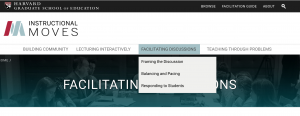WHY IS THIS IMPORTANT?
Evidence continues to accumulate about the increase in course effectiveness when designed with an active learning approach; in-class interaction is associated with improved learning outcomes for all students, while often decreasing the achievement gap for underrepresented minority students. In a 2012 National Research Council report, Discipline-Based Education Research: Understanding and Improving Learning in Undergraduate Science and Engineering, “the committee characterized the strength of the evidence on making lectures more interactive as strong”.
See the “Key Peer-Reviewed Studies” section below for more information.
HOW CAN I IMPLEMENT THIS SUCCESSFULLY?
Just want to see one video? We like this one linked above, especially if you want to see active learning implemented in a large lecture hall.
WANT TO DIG DEEPER?
Theobald et al. (2020, PNAS) – “Active learning narrows achievement gaps for underrepresented students in undergraduate science, technology, engineering, and math“
Freeman et al. (2014, PNAS) performed a meta-analysis of 225 studies to find active learning associated with increased learning and decreased failure across the sciences.
Haak et al. (2011, Science) found that a “high-structured” active learning class (i.e. one with multiple weekly assignments and regular student engagement) decreased achievement gaps between “advantaged” and “disadvantaged” groups.
Ballen, Wieman et al. (2017, CBE-Life Sciences) found that active learning closed the achievement gap between underrepresented groups and non-underrepresented groups, mainly by increasing the self-efficacy of both groups of students.
The following resource outlines several active learning strategies that you can use in your classroom, categorized by effort and research validation: Active Learning Activities by Effort
Wondering how to introduce your students to this type of learning, and “frame” the classroom structure to them?
https://www.physport.org/recommendations/Entry.cfm?T=productive%20engagement
In this set of Expert Recommendations, you will find research-based (not necessarily research-tested) recommendations for helping students get introduced to and engaged productively in active learning, along with concrete examples of how to incorporate these ideas in your classroom. Compiled by Stephanie Chasteen of the University of Colorado Boulder in collaboration with Andrew Boudreaux of Western Washington University and Jon Gaffney of Eastern Kentucky University.
For a pdf summary, go here: https://www.physport.org/recommendations/files/Framing%20Summary%20and%20Checklists.pdf.
The Summer Institutes on Scientific Teaching empower and inspire instructors to transform STEM education through evidence-based teaching practices. This collection of Summer Institute teaching tidbit materials can help you incorporate interactive activities in your own classroom.
The following source is an open -access journal of peer-reviewed teaching resources for undergraduate biological sciences. Course Source
- Here is a collection of activities, organized by subject and type of activity, curated by Carleton College Science Education Resource Center.
- Here is the MERLOT collection of in-class activities, case studies, tutorials, etc., which you can search by subject and audience, including peer review and user ratings.
- Here is a collection of active learning materials for a range of STEM course transformations, curated by the the CU Boulder Science Education Initiative.
Learn how to effectively implement the CREATES method for understanding scientific articles here.
The following resource provides multimedia resources, including apps, animations, videos, interactives, and virtual labs, to bring the excitement of scientific discovery into your classroom. BioInteractive
The following resource develops assessment that can inform instruction, in particular in assessing how undergraduates trace matter, energy and/or information through biological and geological processes at multiple scales. Diagnostic Question Cluster (DQC) Group
The following resource maintains more than 700 peer-reviewed cases centered on STEM case studies for use at the undergraduate, graduate, and high school level. National Center for Case Study Teaching in Science
The following resource is a listserv that is distributed monthly, containing active learning of ecological concepts, reports and articles on stem education and science education research, as well as new resources in ecology education digital library. Jigsaw Newsletter


